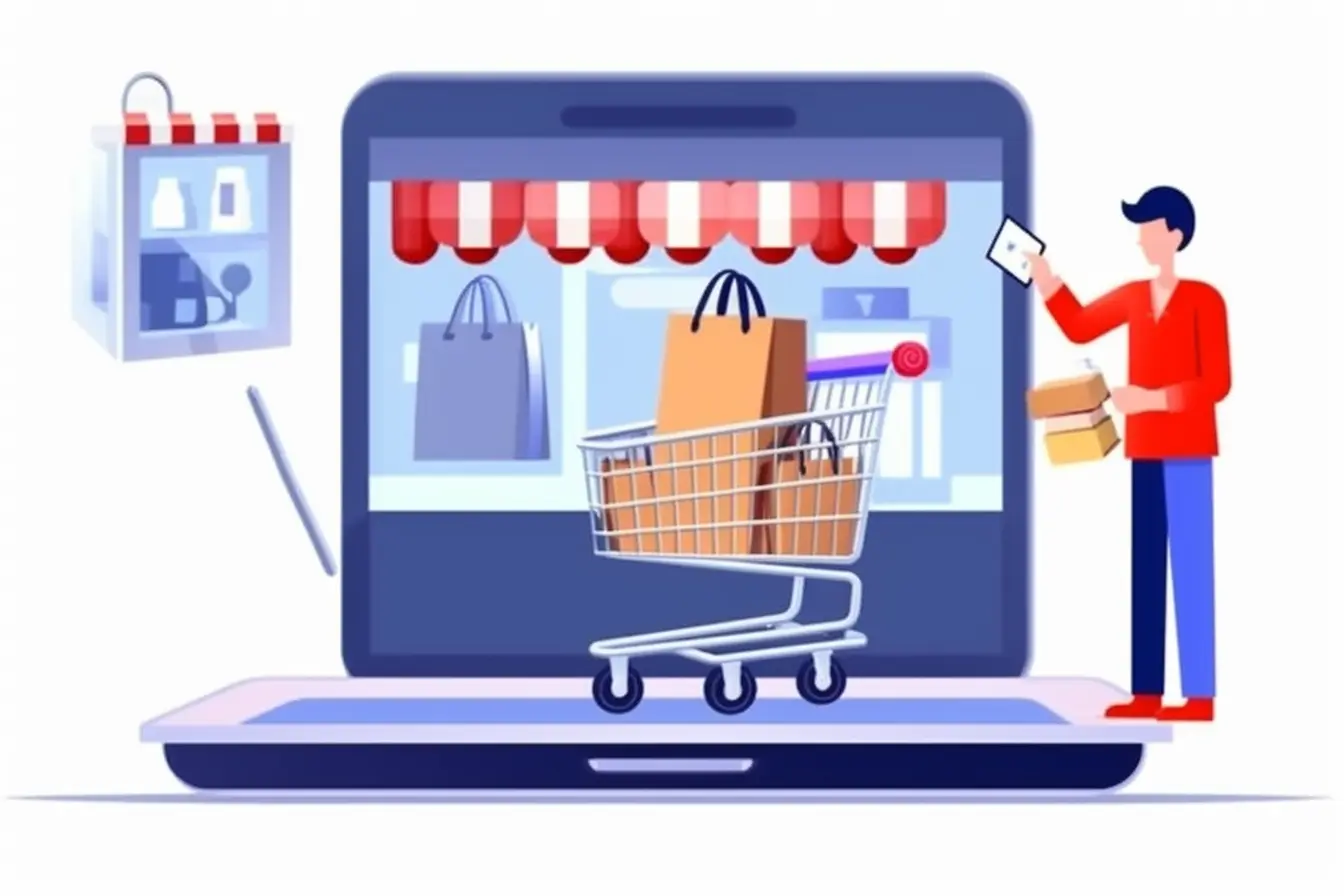
E-commerce, also known as electronic commerce, has revolutionized the way businesses operate in the modern digital age. With the advent of the internet, the buying and selling of goods and services, as well as the transmission of funds and data, have been made easier and more convenient. In this comprehensive guide, we will explore the concept of e-commerce, its various types, how it works, its advantages and disadvantages, as well as its history and future trends.
E-commerce
E-commerce, or electronic commerce, refers to the buying and selling of goods and services, as well as the transmission of funds or data, over an electronic network, primarily the internet. It encompasses a wide range of business transactions, including business-to-business (B2B), business-to-consumer (B2C), consumer-to-consumer (C2C), and consumer-to-business (C2B) interactions. E-commerce has become increasingly popular in recent years, with the rise of online marketplaces such as Amazon and eBay.
Types of E-commerce
It can be categorized into several types based on the parties involved in the online transactions. These include:
1. Business-to-Business (B2B) E-commerce
B2B refers to the electronic exchange of products, services, or information between businesses rather than between businesses and consumers. It involves online directories, product and supply exchange websites, and e-procurement interfaces. B2B e-commerce is predicted to reach $1.8 trillion by 2023 and account for 17% of U.S. B2B sales.
2. Business-to-Consumer (B2C) E-commerce
B2C is the retail part of e-commerce on the internet. It involves businesses selling products, services, or information directly to consumers. Examples include online stores and marketplaces like Amazon, which dominate the B2C market.
3. Consumer-to-Consumer (C2C) E-commerce
C2C involves consumers trading products, services, and information with each other online. This is typically facilitated through online platforms like eBay and Craigslist, where individuals can buy and sell goods directly to other consumers.
4. Consumer-to-Business (C2B) E-commerce
C2B is a type of e-commerce in which consumers make their products and services available online for companies to bid on and purchase. This is the opposite of the traditional commerce model and is commonly seen in platforms like iStock, where individuals sell royalty-free photos, media, and design elements.
5. Business-to-Administration (B2A) E-commerce
B2A refers to online transactions conducted between businesses and public administration or government bodies. It involves various e-services and products related to legal documents, registers, social security, fiscal data, and employment.
6. Consumer-to-Administration (C2A) E-commerce
C2A involves online transactions between consumers and public administration or government bodies. It includes activities such as distributing information and making payments related to social security, taxes, and health services.
7. Mobile E-commerce (M-commerce)
M-commerce refers to online sales transactions conducted using mobile devices, such as smartphones and tablets. It includes mobile shopping, banking, and payments, often facilitated by mobile chatbots.
How E-commerce Works
It is powered by the internet, enabling customers to access online stores and place orders for products or services through their own devices. When a customer places an order, their web browser communicates with the server hosting the website. Data related to the order is relayed to an order manager, which then updates inventory levels, manages payment information, and notifies the customer that their order has been successfully processed. The order data is then sent to the warehouse or fulfillment department for shipping or granting access to a service.
Its transactions can take place on various platforms, such as online marketplaces like Amazon, software as a service (SaaS) tools that provide online store infrastructures, or open-source platforms managed by in-house developers.
Advantages of E-commerce
It offers several advantages that have contributed to its widespread adoption and growth. These advantages include:
1. Availability
Their sites are available 24/7, allowing customers to browse and shop at any time, unlike physical stores with fixed operating hours.
2. Speed of Access
Their sites load quickly, allowing customers to browse product catalogs and complete transactions in a matter of minutes, providing a seamless shopping experience.
3. Wide Availability
It enables brands to make a wide array of products available, which are then shipped from warehouses after a purchase is made. This increases the likelihood of customers finding exactly what they want.
4. Easy Accessibility
Their sites offer easy accessibility to products through intuitive user interfaces and search features, enabling customers to quickly find and purchase desired items.
5. International Reach
They allows businesses to sell to customers worldwide, expanding their customer base beyond geographical limitations. This global reach opens up new opportunities for growth and revenue.
6. Lower Cost
Pure-play e-commerce businesses avoid the costs associated with physical stores, such as rent, inventory management, and cashiers. Although there may be shipping and warehouse costs, the overall costs are often lower compared to traditional retail.
7. Personalization and Product Recommendations
Their sites can track customer browsing and purchase history, enabling them to provide personalized product recommendations and insights about target markets. This enhances the customer experience and increases the likelihood of repeat purchases.
Disadvantages of E-commerce
While it offers numerous advantages, it also presents some challenges and disadvantages that businesses and consumers should be aware of. These include:
1. Limited Customer Service
Their sites may have limited customer service options, such as restricted support hours or complex online service navigation. This can make it challenging for customers to seek assistance when needed.
2. Limited Product Experience
Online shopping lacks the ability to physically experience products before purchase. Customers rely on images and descriptions, which may not always accurately represent the actual product. This can result in customer dissatisfaction and the need for returns.
3. Wait Time
Unlike physical stores where customers can immediately take home their purchases, it requires shipping time. Although next-day and same-day delivery options are becoming more common, there is still a waiting period before customers receive their products.
4. Security Risks
Their transactions involve the exchange of sensitive information, such as credit card details. The risk of data breaches and unauthorized access to customer information is a significant concern for both businesses and consumers.
E-commerce Applications
E-commerce has various applications across different industries and sectors. Retail apps utilize online marketing techniques, such as email campaigns, online catalogs, and shopping carts, to attract customers and facilitate transactions. Other applications include electronic data interchange (EDI), file transfer protocol, web services, and mobile applications. These technologies enable businesses to streamline their operations, enhance customer experiences, and increase sales.
E-commerce Platforms and Vendors
To effectively manage a business, various platforms and vendors offer solutions tailored to different business sizes and needs. Online marketplaces like Amazon and eBay provide user-friendly platforms for businesses to sell products without the need for extensive IT implementation. Software as a Service (SaaS) platforms, such as BigCommerce, Magento, and Shopify, offer customizable and scalable solutions that businesses can subscribe to. Open-source platforms like WooCommerce provide flexibility for companies to manage their e-commerce systems using in-house developers.
Government Regulations for E-commerce
Activities are subject to government regulations that aim to protect consumers and ensure fair business practices. In the United States, the Federal Trade Commission (FTC) monitors online advertising, content marketing, and customer privacy. The Payment Card Industry (PCI) Security Standards Council develops standards and rules, including PCI Data Security Standard compliance, to safeguard consumers’ financial data. Businesses must authenticate transactions, control access to resources, encrypt communications, and implement security technologies to ensure data privacy and protect against cyber threats.
The History of E-commerce
It has a rich history that dates back to the 1960s when businesses started using electronic data interchange (EDI) to share business documents electronically. In the late 1990s, online marketplaces like eBay and Amazon emerged, revolutionizing the e-commerce industry. Since then, the e-commerce market has experienced significant growth, with the COVID-19 pandemic further accelerating its adoption. Its sales reached a record high of 16.4% of total retail sales in the second quarter of 2020, according to the U.S. Census Bureau.
The Future of E-commerce
The future of e-commerce looks promising, with continuous advancements in technology and changing consumer behaviors. The widespread adoption of mobile devices and voice assistants is expected to drive the growth of mobile and voice-activated transactions. The integration of augmented reality (AR) and virtual reality (VR) technologies into platforms will enhance the customer’s ability to examine and visualize products before making a purchase. Additionally, the ongoing development of AI and machine learning will enable more personalized shopping experiences and improved customer service.
It has transformed the way businesses operate and customers shop. Its various types, such as B2B, B2C, C2C, and C2B, cater to different market segments and consumer needs. The advantages of e-commerce, including availability, speed of access, wide availability, easy accessibility, international reach, lower cost, and personalization, have made it a preferred choice for many businesses. However, it also presents challenges such as limited customer service, limited product experience, wait time, and security risks. By leveraging platforms, businesses can tap into the immense potential of online retail and reach a global customer base. As technology continues to evolve, its future looks promising, with the integration of mobile, AI, AR, and VR technologies enhancing the customer experience and driving further growth in the industry.
At WeCreate Digital Marketing Agency, we’re committed to helping you unlock the full potential of e-commerce, driving growth, and maximizing your online presence. If you have any questions or are ready to embark on this exciting journey with us, don’t hesitate to get in touch. We’re here to transform your e-commerce vision into reality.



